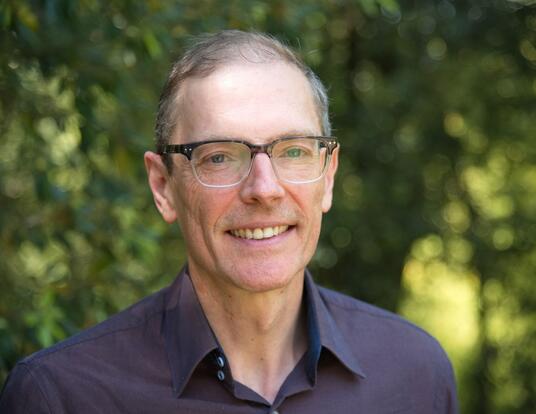Colloquy Podcast: The Queer Survival of Sappho
Sappho, the renowned lyric poet who wrote and lived on the island of Lesbos in Greece in the sixth century BCE, has inspired countless authors who imitate her writing and explore her identity as a mythic and historical figure. In this talk given at the 2025 Harvard Horizons Symposium, English PhD candidate Katherine Horgan explores the legacy of the ancient Greek poet in her project, "Living Sappho: Imitation, Imagination, and Revivification in Early Modern England," which examines the many texts that have carried Sappho’s legacy as both poet and queer woman over the centuries.
This transcript has been edited for clarity and correctness.
The ancient Greek poet Sappho has been famous for a very long time. Born nearly 2,600 years ago, she is older than even the most venerable of Alex's elderly poets. She lived on the island of Lesbos, which is a small island off the coast of Greece in the Mediterranean, where she became so famous for her poetry that she's been celebrated over millennia by poets and authors, from Plato to Anne Carson. In antiquity, Sappho was so renowned that she gained the nickname the Tenth Muse, a promotion from mortal poet to immortal goddess of poetry that is unique in our canonical literature.
In addition to being a famous ancient female poet, Sappho is also a famous ancient queer poet. Sappho wrote her love poetry to women. She was said to have had many female lovers, and her gender was a fascinating combination of masculine and feminine elements. Today, Sappho is as well known for her sexuality as she is for her poetry. Many of our modern words for female homosexuality, like "sapphic" and "lesbian," derive from Sappho's name and biography.
However, about 1,000 years ago, this absurdly famous queer poet and all of her famous queer poetry disappeared. Today, Sappho's poetry comes down to us in fragments, unearthed on bits of papyrus by archaeologists, like Sergio and Mac, or identified as quotations in other texts by literary scholars, like Alex and myself.
Only some 600 fragments and one complete poem remain of a corpus that once filled nine books. And this is all that's left of the most famous lyric poet of the classical world. Because of this loss of her poetry, scholars say that Sappho has a problem of what we call transmission. And this is a vocab word. It's on the test.
Transmission is the word we use to describe how texts move through time with the help of scholars, scribes, printers, and readers and writers at large from one historical moment to another. And to show you an example of what I mean, let's look at an author with a good transmission history, like Aristotle.
Scholars have a very good idea of how Aristotle's work has moved through time and technology, from papyrus scroll to handwritten manuscript book, to early printed book, to modern downloadable edition. At any given point in history, we have a decent idea of how readers accessed Aristotle and where those texts came from.
But in Sappho's case, we have very little idea of how her poetry was transmitted, from the seventh century BCE, when she was writing, to our moment today, April 8, 2025. Now, don't panic. We do know some things. We know, for example, that Sappho's poetry was continuously read and copied for 1,200 years—not bad at all—from the seventh century BC to the seventh century AD, which is the date of our last existing papyrus.
And we also know that Sappho's poetry reappears in fragments in the Renaissance—think Shakespeare— when printers compiled early editions of her remaining fragments. But between the seventh century AD and the year 1560, there is a gap in Sappho's transmission history, a lot of gaps tonight. We have very little idea of how Sappho's poetry was transmitted from the seventh century AD to the 1560s AD or of the processes that led to the fragmentation of her poetry.
For a long time now, contemporary scholars have argued that Sappho's queerness does not survive this gap. Mapping the loss of Sappho's poetry onto historical narratives of the suppression of women's writing and homosexuality, these scholars argue that Sappho's queerness all but disappeared during this period, only to be recovered in the early 20th century, when newly discovered papyri confirmed the queerness of Sappho's poetry. For most contemporary scholars, there was no queer Sappho in the Renaissance.
Initially, my dissertation project focused on understanding the transmission only of Sappho's poetry across this gap. However, in the attempt to do so, I discovered that it was Sappho's queerness that not only survived this gap, but filled this gap in Sappho's transmission history for centuries.
To differently understand this gap, I have proposed the study of Sappho's mythography. Mythography is what I call the study not of poems by Sappho, but of work about Sappho, in which scholars and readers over time have imagined and speculated about who the historical Sappho might have been and what she might have been like.
And to give you an example of one of these mythographic texts, let's look at this commentary by the Italian scholar Angelo Poliziano, who was writing in the 1480s, right in the middle of this gap that I was discussing earlier. In this text, Poliziano instructs readers on how to interpret a reference to Sappho in another book. He explains that a reader should compare Sappho to the ancient philosopher Socrates.
He writes, "Maximus of Tire said that Sappho's way of loving was the same as Socrates. Just as she loved women, so did he love men." It's very, very gay. Not only does Poliziano explicitly name Sappho's queerness at a time when scholars say people did not do this, he backs himself up with three genuine fragments of Sappho's actual poetry more than a century before scholars acknowledge that these poems were even available to be read.
In this mythographic text, Sappho's mythology and her texts are intertwined at every level, with each shaping the transmission of the other and with Sappho's queerness as a fundamental element of both. When we consider mythography as a form of transmission, we dramatically increase the number of texts that we have to study.
While scholars have been focusing mostly on the transmission only of Sappho's poems, we have very little to examine. However, when we add the study of Sappho's mythography, suddenly, we have more texts than we know what to do with. And in all seriousness, if any of you read Latin or Greek, I desperately need help translating, transcribing, and transmitting these works.
My study of Sappho's mythography has allowed me to press our knowledge of this gap in Sappho's transmission back in time, step by step, text by text. When we add these mythographic texts to the timeline I presented earlier, we see that the narrative of Sappho's transmission is not one of lost and found, but rather one of continuous imagination and engagement with her poetry and mythography over millennia. In my framework, this gap in Sappho's transmission history melts away.
It is my hope that this work on Sappho's transmission will not only aid scholars in understanding how Sappho was historically read and interpreted, but also in the study of the transmission of marginalized communities with broken textual histories in general. Sappho is no lost poet, no victim of history, unable to survive in the face of unimaginable oppression. Rather, she has been continually present in poems and plays, in sculptures and statues, and in the minds of the readers who have imagined her again and again and again, regardless of the presence or absence of her poetry.
Finally, it is my hope that this work will provide not only narratives of queer suppression, but queer survival. Sappho did not survive in spite of her queerness, but in fact, because of a queerness that was the continual invitation to create and understand an enduring effort to imagine the future by imagining the past. Thank you.
The Colloquy podcast is a conversation with scholars and thinkers from Harvard's PhD community on some of the most pressing challenges of our time—from global health to climate change, growth and development, the future of AI, and many others.
About the Show
Produced by GSAS Communications in collaboration with Harvard's Media Production Center, the Colloquy podcast continues and adds to the conversations found in Colloquy magazine. New episodes drop each month during the fall and spring terms.
Talk to Us
Have a comment or suggestion for a future episode of Colloquy? Drop us a line at gsaspod@fas.harvard.edu. And if you enjoy the program, please be sure to rate it on your preferred podcast platform so that others may find it as well.
Get the Latest Updates
Join Our Newsletter
Subscribe to Colloquy Podcast
Simplecast




